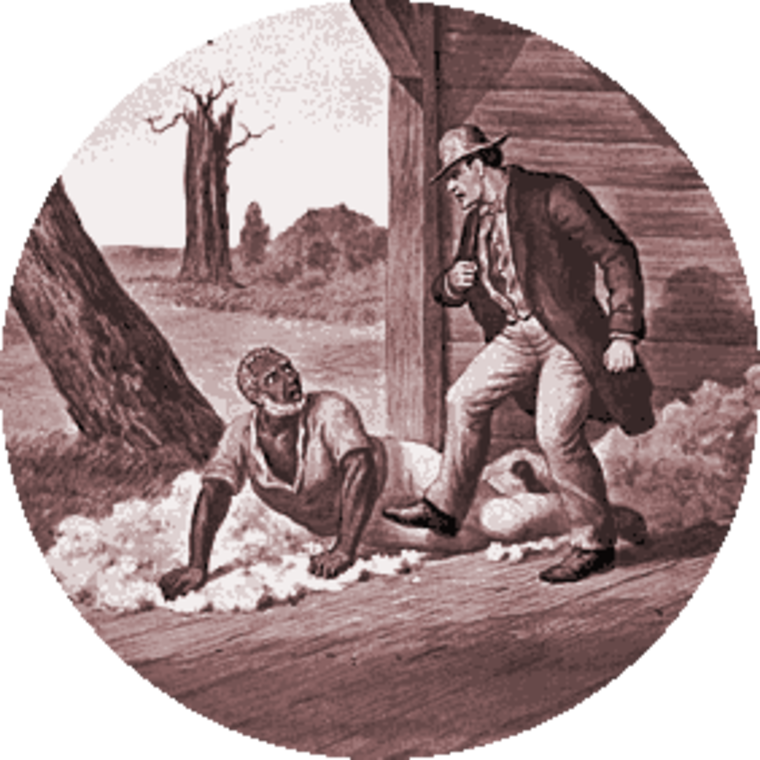| Revision as of 02:10, 12 February 2005 view source24.141.171.2 (talk)No edit summary← Previous edit | Revision as of 18:42, 20 February 2005 view source Pavel Vozenilek (talk | contribs)Extended confirmed users26,226 editsm picture -> frameNext edit → | ||
| Line 1: | Line 1: | ||
| ⚫ | ] | ||
| <div style="float:right; width:291px; padding:10px;"> | |||
| ⚫ | ] |
||
| <center>''Simon Legree menaces Uncle Tom''</center> | |||
| </div> | |||
| '''''Uncle Tom's Cabin''''' is a ] by ] which has ] as one of its main themes. Stowe had written the novel as an angry response to the ] passage of the ], which punished those who aided runaway slaves and diminished the rights of fugitive as well as freed slaves. Many writers have credited this novel with doing much to inflame the passions of Northerners to work for the ], although other writers dispute the novel's influence. ''Uncle Tom's Cabin'' was first published on ], ]. | '''''Uncle Tom's Cabin''''' is a ] by ] which has ] as one of its main themes. Stowe had written the novel as an angry response to the ] passage of the ], which punished those who aided runaway slaves and diminished the rights of fugitive as well as freed slaves. Many writers have credited this novel with doing much to inflame the passions of Northerners to work for the ], although other writers dispute the novel's influence. ''Uncle Tom's Cabin'' was first published on ], ]. | ||
Revision as of 18:42, 20 February 2005

Uncle Tom's Cabin is a novel by Harriet Beecher Stowe which has slavery as one of its main themes. Stowe had written the novel as an angry response to the 1850 passage of the Fugitive Slave Act, which punished those who aided runaway slaves and diminished the rights of fugitive as well as freed slaves. Many writers have credited this novel with doing much to inflame the passions of Northerners to work for the abolition of slavery, although other writers dispute the novel's influence. Uncle Tom's Cabin was first published on March 20, 1852.
Before the novel was written, the story was an anti-slavery serial called Uncle Tom's Cabin or, Life Among the Lowly. It ran for eleven-months starting on June 5, 1851 in the National Era abolitionist newspaper.
Stowe lived in Cincinnati, Ohio, and:
- "she observed firsthand several incidents which galvanized her to write famous anti-slavery novel. Scenes she observed on the Ohio River, including seeing a husband and wife being sold apart, as well as newspaper and magazine accounts and interviews, contributed material to the emerging plot.
Famous characters:
- Simon Legree, villainous slave owner whose name has become synonymous with greed
- Topsy, who "just growed"
- Uncle Tom, noble long suffering Christian slave, after whom the book is named. His name has become an epithet.
- Little Eva, saintly white girl whom Uncle Tom befriends.
The term Uncle Tom, an offensive slur directed at African-Americans considered to be humiliatingly subservient to white people, is derived from this novel.
Uncle Tom's Cabin has been made into several movies.
Related articles
- Origins of the American Civil War
- Abolitionism
- Slavery
- History of slavery in the United States
- ISBN 0553212184
External links
- Uncle Tom's Cabin at Project Gutenberg
- University of Wisconsin--Milwaukee special collections
- Project Gutenberg listing
- PBS Africans in America